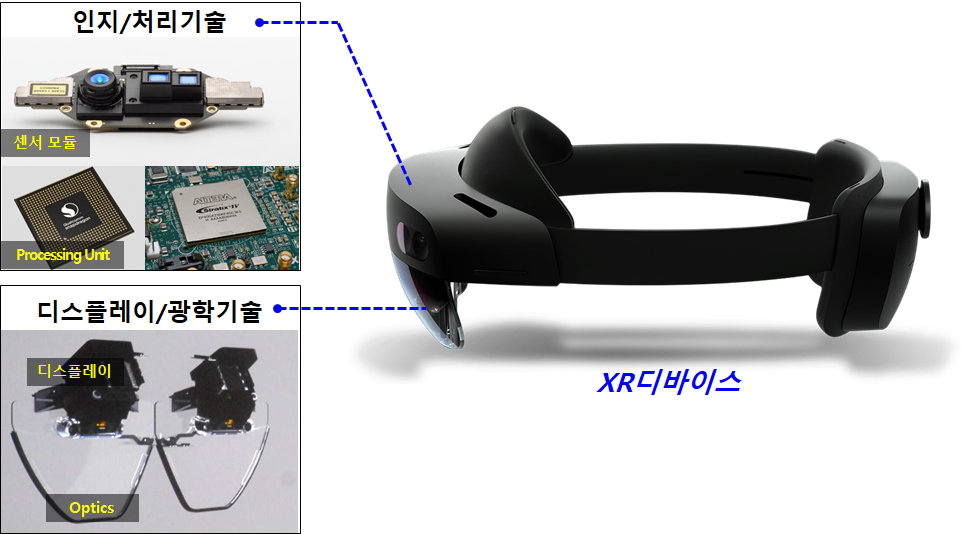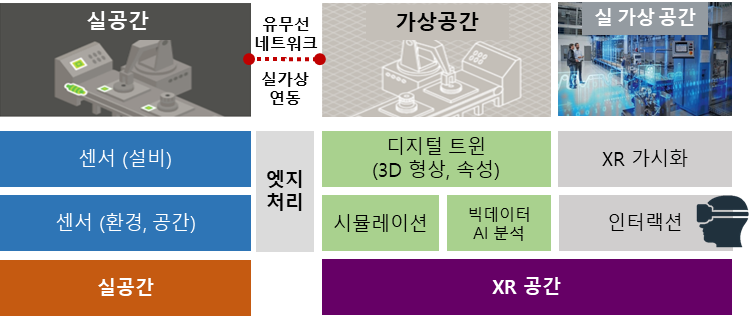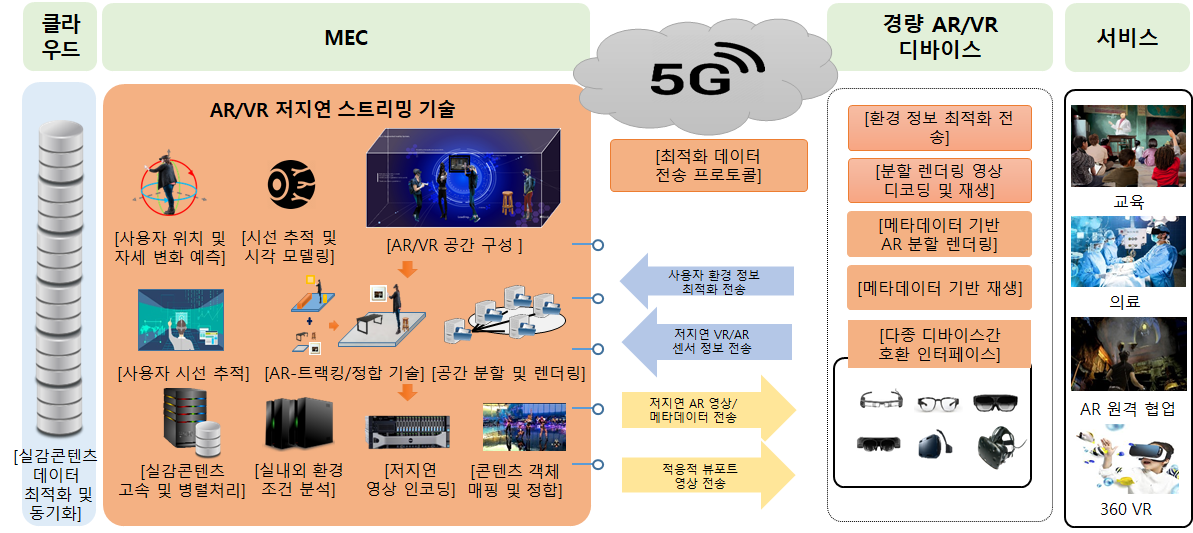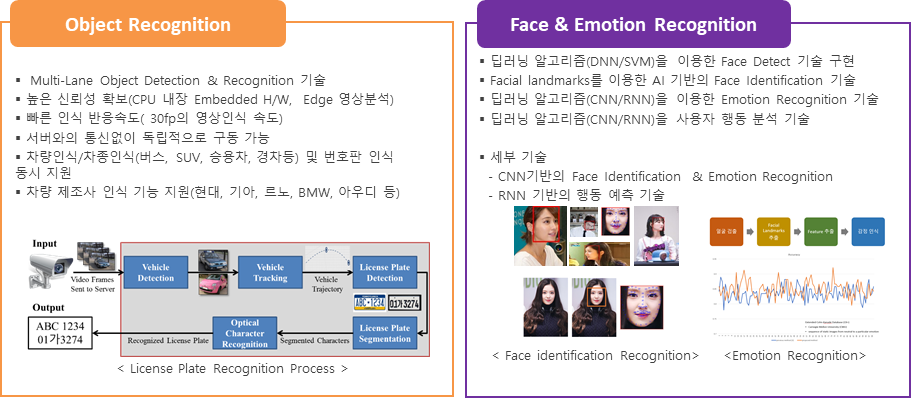METAVERSE(Immersive Media)
Device Technologies Digital twin-based XR technology for
realization of metabuses VR/AR streaming technology for
ultra-realistic 5G service Multi-object recognition technology using
lightweight embedded deep learning technology Extreme Fantasy Seamless
Realistic Platform Technology Spatial Position Loss
Virtual Training Simulator Technology
- XR
- It is a technology that connects and converges reality and virtual reality and implements immersive activity spaces beyond physical constraints, encompassing virtual reality (VR), augmented reality (AR), and mixed reality (MR, VR+AR).
- Technology Overview
-
Technologies for wearable devices and their core components enabling maximization of users’ immersive experiences and ease of spatial restrictions by providing environments combined with virtual and real worlds (Displays and optics) Technologies for generating and presenting virtual content for users (Information processing) Technologies for real-time tracking and recognizing users’ behavioral information such as movement and position of head, body and gaze, hand gestures, voices, etc.

- Necessity and importance
-
(Market forecast) The global VR/AR market is expected to be expanded from \0.9 trillion in 2015 to \74 trillion in 2024 with 41.6% growth of CAGR.
(Government policies) included in Korean government policies such as “Virtual-world industry promotion plan (2016)”, “9 national strategic projects (2016)”, “13 promotion plans for innovational growth engine (2017)”, “Development plans for economics converged with virtual-world (2020)”
- Applications
-
< Applications of XR Devices >
Application Description Realistic Digital Content Maximizatin of users’ Immersive experiences through experiential content
(e.g., large screen content, games, untact services)Medical Industry virtual surgery, virtual anatomy dissection, Tele-health, etc.
Manufacturing Industry Real-time monitoring of manufacturing equipment using digital twin
Industry technology, manufacturing cost reduction and innovative manufacturing process through remote collaboration
Distribution Industry Immersive virtual distribution services, warehouse managements, navigation services for personal and shared mobility
- Technology Overview
-
Technology that creates 3D virtual spaces (objects, people, and environments) with real-world shapes and attributes, simulates them through real-world interactions and real-time interactions in real-world and virtual convergence (XR) environments, and then reproduces and visualizes changes.

- Necessity and importance
-
(Markets) The global XR market is expected to grow 76.9% annually from $7.89 billion in 2019 to $136.8 billion in 2024 (Source: IDC) (The size of the domestic XR market) $590 million ('19) → $2.63 billion ('24) (Source: Digi-Capital) (XR Industrial Application Market) $9 billion ('19) → $121 billion ('24) (Source: IDC)
(Policies) Promising technology fields included in the virtual convergence economy development strategy ('20) and the Korean version of the New Deal Comprehensive Plan-DNA ecosystem reinforcement ('20)
- Applications
-
< XR convergence applications >
Application Description Manufacturing XR is applied to the entire stage from product design, production to sales, dramatically reducing production costs and innovating production processes through rapid implementation of prototypes and remote collaboration
Medical In addition to reducing training costs and improving surgery accuracy and safety, it maximizes treatment effects by reproducing specific environments and providing high immersion beyond the limitations of the actual treatment environment
Architecture Architectural civil engineering structures are pre-visible in virtual and augmented environments and are designed and simulated-based analysis and verification
Distribution The distribution paradigm shifts from existing online and mobile distribution to an XR-based immersive virtual distribution environment, providing consumers with a new experience
- Technology Overview
-
Realistic content streaming technology that can achieve light weight and structural simplification of devices by providing computing resources of 5G MEC to VR and AR devices.
Real-time, high-definition, large-capacity realistic content technology that combines edge computing (edge cloud) to devices so that real-time, high-definition, and large-capacity realistic content (education, defense, medical, games, etc.) can be used through the network.
Core technology for high-quality realistic content that can provide services without dissonance and heterogeneity of human five senses in devices for realistic content on 5G networks that support low-latency streaming.

- Necessity and importance
-
(Markets) The global realistic content industry is expected to increase 52.6% annually from $28.9 billion in 2017 to $364.1 billion in 2023 (Source: Statista, Global Industry Analysts)
(Policies) This technology is in line with the government's "Three Innovation Strategies in the Content Industry ('19)" and the "Virtual Convergence Economy Development Strategy ('20)" as well as the leading realistic content development strategy.
- Applications
-
< VR/AR streaming technology application >
Application Description VR and AR smart factory service Maintenance manual, drawings, maintenance video, facility management operation information real-time provision service
Productivity and efficiency improvement services through accidental failure detection and systematic maintenance support
VR and AR smart education services A service that links realistic educational content that can be used for immersive/creative education with 5G edge cloud
A service that provides personal educational content such as museum docents and documentaries through realistic VR and AR videos
VR and AR ultra-high quality video streaming service Idols, SNS stars, music shows, performances, travel healing, webtoons, and game services that are more vivid than reality
16K-class ultra-high quality realistic 360° tour guide, drone video, high-quality video streaming, and sports relay service
High-quality volume metric (3D stereoscopic) AR service with 360° stereoscopic photographing technology compared to the existing AR (Pokemon game)
- Technology Overview
-
Lightweight deep learning technology capable of recognizing and classifying objects of images input in real time on an embedded OS-based edge device. It is a self-developed AI-based image analysis algorithm and engine that can recognize and classify objects in edge devices. It can be applied to AI-based vehicle cameras to detect a combination of vehicles, pedestrians, and unexpected situations. Human interaction technology can be developed through user emotion and face recognition.

- Necessity and importance
-
(Markets) The global image analysis market is expected to grow 20.55% annually from 4.9 billion USD ('15) to 11.7 billion USD ('25)
(Policies) One of the strategic investment areas of the Ministry of Economy and Finance's "Innovation Growth Strategy Investment Direction" (18.8)
- Applications
-
< Multi-object recognition technology for edge devices Application field >
Application Description Intelligent camera Not only crime prevention such as theft, but also customer analysis, road control, factory automation, etc.
When approaching within 2m due to COVID-19, it is applied to whether it is an action such as warning or cough recognition
In addition to the existing monitoring purposes, marketing application through analysis of customer patterns in stores is applied
Smart Farm Application for smart agriculture by spraying herbicides only on weeds through object recognition
Application for packaging selected products and identifying information on crop growth based on video
Self-driving It is increasing the efficiency and safety of ADAS by attaching front and side cameras
Application of situational cognitive technology for fully autonomous driving
- Technology Overview
-
Technology that provides a dramatic and fantastic Extreme Fantasy experience based on storytelling to experienced people Seamless experience is possible for each content scenario Modularization/connection of components of the walking/airspace/rock climbing environment platform

- Necessity and importance
-
(Markets) The virtual reality market is expected to record an average annual growth rate of 33.5% from 2018 to 2024, and sales in the VR hardware sector are also growing accordingly
(Policies) The establishment of a virtual reality and augmented reality ecosystem is selected as a national strategic project and is intensively fostering it, and VR/AR is selected as one of the core industries of the 4th industrial revolution
- Applications
-
It is used for VR-based dynamic e-sports platforms and non-face-to-face VR-based home training platforms for urban indoor park
Various boarding modules are manufactured and used as multi-purpose VR simulators
< Virtual reality application field >
Application Description Sports/Culture VR-based e-sports platform, non-face-to-face VR-based home training platform, and cultural and artistic performances
Education VR-based Metaverse platform, a non-face-to-face SNS in the future
Industry VR-based safety experience training
- Technology Overview
-
Development of a spatial loss virtual training system including a 360°Yaw motion platform-based simulator, a virtual reality (VR) basic training simulator, a biosignal monitoring system, and a training management system Providing visual/ vestibular engine-based spatial loss training using 360°Yaw + 6 DOF (Degrees Of Freedom) motion platform and providing a low-cost training model through VR basic training simulator Technology for analyzing the connection between spatial loss-biological signals through linkage of spatial loss simulators, bio-signal monitoring systems, and training management systems

- Necessity and importance
-
(Markets) It can contribute to preventing serious accidents caused by loss of spatial quality, thereby reducing the cost of losing advanced pilots' manpower Expecting the inflow of trainees by establishing a hub for overseas pilots Effect of inflow of overseas trainees and reduction of overseas consignment education costs ($1,200/1 person): Expected 6,000 domestic pilots.
(Policies) This technology is also in line with the government's "Virtual Convergence Economy Development Strategy" ("20)" and "Basic Plan for the Promotion of the Spatial Information Industry".
- Applications
-
< Application field of virtual training system for spatial loss >
Application Description Flight training Development of a virtual training simulator for spatial loss of fixed-wing aircraft and rotary-wing aircraft
Development of Upset Prevention Recovery Training (UPRT) training system
Driving training Development of a training system for driving automobiles and motorcycles using motion platforms
Development of heavy equipment training systems such as excavators and forklifts
Entertainment Development of motion platform-based movie theaters and virtual reality entertainment systems
Copyright(C) 2016 KOREA ELECTRONICS TECHNOLOGY INSTITUTE., All Rights Reserved.


